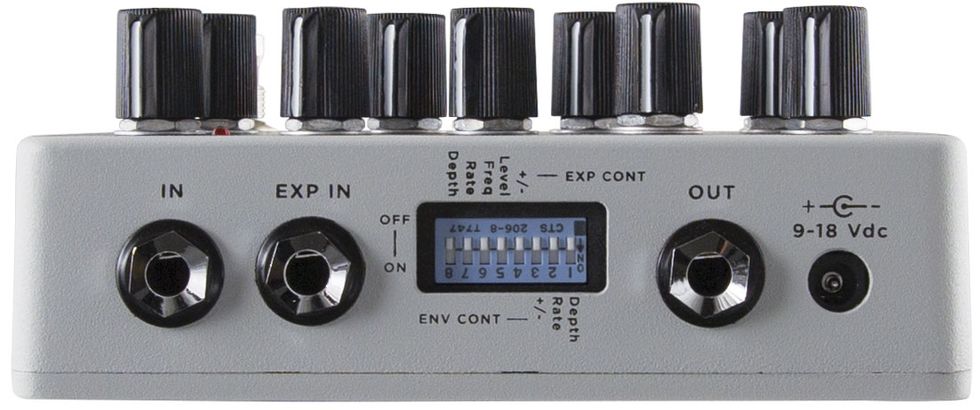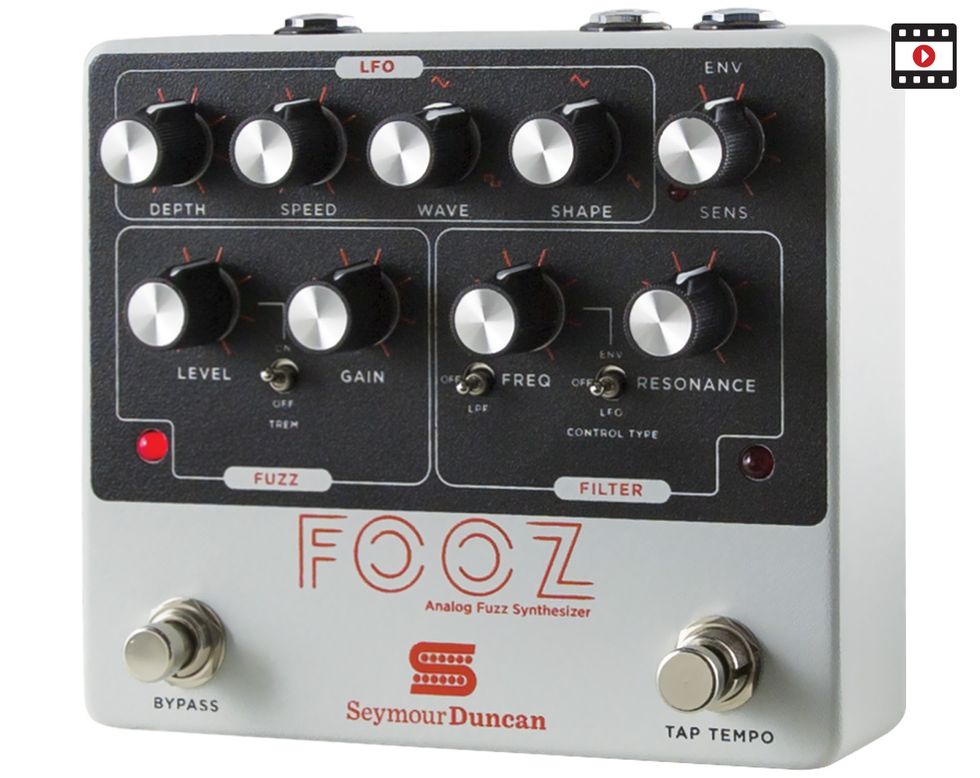RatingsPros:Fun and intuitive analog-synth-style control layout. Effective, rangy filter controls. Rich, varied modulation textures. Cons: A touch pricey. Street: $349 Seymour Duncan Fooz Analog Fuzz Synthesizer seymourduncan.com | Tones: Ease of Use: Build/Design: Value: |
Analog synthesizers are a favorite source of creative therapy. The process of noodling slow, simple, meandering melodies while tweaking filters, envelope parameters, and modulation rates can yield music from the comic to the sublime. But almost without fail, the sounds I make shake me back to a more open-minded creative perspective. And the little composition-by-Zen voyages I have along the way are typically pretty re-energizing and productive, too.
Seymour Duncan’s Fooz Analog Fuzz Synthesizer can energize guitar-based creativity in similar ways. It’s capable of sounds from subtle to severely mutilated, and its many fuzz, modulation, and filtering textures can make chords and licks you’ve flogged to death sound fresh. It is also versatile—with fuzz, modulation, and filtering sections that can be used independently in familiar ways, or combined to generate complex mutant sounds. And with an interface and circuit that mimics an analog synth in many respects, it encourages the kind of unconscious, creative wandering and tone sculpting that makes an old Moog so much fun.
The Fuzz Bone’s Connected to the Mod’ Bone
If you’ve tinkered with old analog synths, you’ll probably find the Fooz’s simpler-than-it-looks control set familiar and inviting. The effects are grouped in modular blocks dedicated to the fuzz, the LFO-driven modulation section, and the filter controls. There’s also an envelope sensitivity control that regulates the sweep and dynamic reactivity of the envelope filter. The two footswitches bypass the effect and provide tap tempo input for the modulation rate.
The Fooz’ top panel is streamlined, too. Lacking stereo capabilities or MIDI control options, the I/O set is limited to an input, an output, and an expression pedal input. But the top panel is also home to a small recessed area featuring eight DIP switches that enable you to reverse the direction of the envelope sweep, reverse envelope control of rate and depth of the LFO, and assign functions including volume, frequency, rate, and depth to an expression pedal (not included).
Pulses, Sweeps, and Formidable Fuzz
Though some may lament the Fooz’s lack of MIDI control and other options that add power and complexity to guitar synths and synth-type pedals, there’s a lot to be said for the ease with which you can extract rich, highly usable sounds.
The Fuzz section alone is remarkable for its many shades of gain. With the gain at near-zero settings you can almost dial out the fuzz entirely, though the output retains a touch of grit and some of the fuzz’s snorkely mid-forward voice. The fuzz itself, as suits a circuit requiring consistent input to drive the LFO and filters, is not the most dynamic, but it’s got a great deal of character. The basic voice has characteristics of a slimmed down, treblier Big Muff and something like a silicon Fuzzrite. It’s buzzy, sustains for days, and isn’t colored too heavily on either side of the frequency spectrum. Those qualities make it ideal for tone shaping with the filter section. My favorite fuzz sounds came via the band pass filter setting, which I could fine tune with the frequency and resonance controls. The low pass filter helps you shape some of the fattest, synthiest fuzz tones and gives you leeway to introduce more dramatic resonant peaks with the resonance control. Both the frequency and resonance controls have excellent range, by the way, and can be used for detailed sculpting and radical tone shifts.
Wobbling Your Way Home
The LFO section can be used as a tremolo or to modulate the filtered output with an un-modulated tone in parallel. Both applications are a blast. The tremolo is flexible, with rangy controls for rate and depth, a waveform knob that enables blends of sine, sawtooth, and square waves, and a wave shape control that enables you to tailor ramp-up and ramp-down rates. You can also modify the tremolo radically with the filter and envelope sections, and adding emphasis to specific frequencies with the filter section can color the tremolo pulses in myriad ways.

For example, the combination of contoured, amp-like tremolo waveforms, lower resonance settings, cloudy low pass filter and frequency settings, and mid-gain fuzz yields uncommon smoky and mysterious undulations that blur the line between organic, traditional, and artificial. You can also create fuzzy, throbbing Vox Repeat Percussion-style sawtooth pulses, or dial in peaky, resonant pulses that will cut through the densest, most chaotic musical mélange. Using the envelope filter with the tremolo, meanwhile, enables dynamic control of your tremolo pulses when you vary your picking intensity.
Using the LFO sans tremolo yields more traditionally synthy textures with all the same wave- and tone-sculpting power available in tremolo mode. Moderately fast LFO rates at high depth settings enable killer Doppler sweeps (which you can perform manually or with the expression pedal) that evoke Pete Townshend’s pulsing EMS filter sounds. Extra-slow modulation rates mated to sine waves, low pass filter settings, and high resonance and frequency rates give fuzzed-out, droney chords a layer of lazy, sweeping filter tones that sound like lonely desert wind. These are just a few of the textures, tones, and colors you can achieve through crafty recombination of the Fooz’s powerful functions.
The Verdict
Though it’s certainly not as fat sounding as a vintage VCO-driven keyboard synthesizer, the Fooz often feels more like a real synth than a guitar pedal designed to deliver synth-like sounds. Sometimes that means you might forego fancy licks and use your guitar more as a tone generator. But again, the magic of a synthesizer is often in its power to break old habits. The Fooz delivers much of that magic—along with very practical guitar-centric features—in a box that’s intuitive, musical, and versatile.
Watch the First Look:








![Rig Rundown: Russian Circles’ Mike Sullivan [2025]](https://www.premierguitar.com/media-library/youtube.jpg?id=62303631&width=1245&height=700&quality=70&coordinates=0%2C0%2C0%2C0)

















